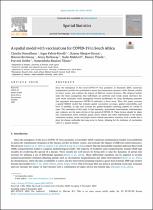JavaScript is disabled for your browser. Some features of this site may not work without it.
- ResearchSpace
- →
- Research Publications/Outputs
- →
- Conference Publications
- →
- View Item
| dc.contributor.author |
Dresselhaus, C

|
|
| dc.contributor.author |
Fabris-Rotelli, I

|
|
| dc.contributor.author |
Manjoo-Docrat, R

|
|
| dc.contributor.author |
Brettenny, W

|
|
| dc.contributor.author |
Holloway, Jennifer P

|
|
| dc.contributor.author |
Abdelatif, N

|
|
| dc.contributor.author |
Thiede, R

|
|
| dc.contributor.author |
Debba, Pravesh

|
|
| dc.contributor.author |
Dudeni-Tlhone, Nontembeko

|
|
| dc.date.accessioned | 2023-12-12T11:17:21Z | |
| dc.date.available | 2023-12-12T11:17:21Z | |
| dc.date.issued | 2023-12 | |
| dc.identifier.citation | Dresselhaus, C., Fabris-Rotelli, I., Manjoo-Docrat, R., Brettenny, W., Holloway, J.P., Abdelatif, N., Thiede, R. & Debba, P. et al. 2023. A spatial model with vaccinations for COVID-19 in South Africa. <i>Spatial Statistics, 58.</i> http://hdl.handle.net/10204/13403 | en_ZA |
| dc.identifier.issn | 2211-6753 | |
| dc.identifier.uri | https://doi.org/10.1016/j.spasta.2023.100792 | |
| dc.identifier.uri | http://hdl.handle.net/10204/13403 | |
| dc.description.abstract | Since the emergence of the novel COVID-19 virus pandemic in December 2019, numerous mathematical models were published to assess the transmission dynamics of the disease, predict its future course, and evaluate the impact of different control measures. The simplest models make the basic assumptions that individuals are perfectly and evenly mixed and have the same social structures. Such assumptions become problematic for large developing countries that aggregate heterogeneous COVID-19 outbreaks in local areas. Thus, this paper proposes a spatial SEIRDV model that includes spatial vaccination coverage, spatial vulnerability, and level of mobility, to take into account the spatial–temporal clustering pattern of COVID-19 cases. The conclusion of this study is that immunity, government interventions, infectiousness and virulence are the main drivers of the spread of COVID-19. These factors should be taken into consideration when scientists, public policy makers and other stakeholders in the health community analyse, create and project future disease prevention scenarios. Such a model has a place for disease outbreaks that may occur in future, allowing for the inclusion of vaccination rates in a spatial manner. | en_US |
| dc.format | Fulltext | en_US |
| dc.language.iso | en | en_US |
| dc.relation.uri | https://www.sciencedirect.com/science/article/pii/S2211675323000672?via%3Dihub | en_US |
| dc.source | Spatial Statistics, 58 | en_US |
| dc.subject | Covid-19 | en_US |
| dc.subject | Vaccinations | en_US |
| dc.subject | SEIRDV model | en_US |
| dc.subject | Spatial vaccination coverage | en_US |
| dc.title | A spatial model with vaccinations for COVID-19 in South Africa | en_US |
| dc.type | Article | en_US |
| dc.description.pages | 12 | en_US |
| dc.description.note | © 2023 The Author(s). Published by Elsevier B.V. This is an open access article under the CC BY-NC-ND license (http://creativecommons.org/licenses/by-nc-nd/4.0/). | en_US |
| dc.description.cluster | Next Generation Enterprises & Institutions | en_US |
| dc.description.cluster | Smart Places | en_US |
| dc.description.impactarea | Data Science | en_US |
| dc.description.impactarea | ISSR Management Area | en_US |
| dc.identifier.apacitation | Dresselhaus, C., Fabris-Rotelli, I., Manjoo-Docrat, R., Brettenny, W., Holloway, J. P., Abdelatif, N., ... Dudeni-Tlhone, N. (2023). A spatial model with vaccinations for COVID-19 in South Africa. <i>Spatial Statistics, 58</i>, http://hdl.handle.net/10204/13403 | en_ZA |
| dc.identifier.chicagocitation | Dresselhaus, C, I Fabris-Rotelli, R Manjoo-Docrat, W Brettenny, Jennifer P Holloway, N Abdelatif, R Thiede, Pravesh Debba, and Nontembeko Dudeni-Tlhone "A spatial model with vaccinations for COVID-19 in South Africa." <i>Spatial Statistics, 58</i> (2023) http://hdl.handle.net/10204/13403 | en_ZA |
| dc.identifier.vancouvercitation | Dresselhaus C, Fabris-Rotelli I, Manjoo-Docrat R, Brettenny W, Holloway JP, Abdelatif N, et al. A spatial model with vaccinations for COVID-19 in South Africa. Spatial Statistics, 58. 2023; http://hdl.handle.net/10204/13403. | en_ZA |
| dc.identifier.ris | TY - Article AU - Dresselhaus, C AU - Fabris-Rotelli, I AU - Manjoo-Docrat, R AU - Brettenny, W AU - Holloway, Jennifer P AU - Abdelatif, N AU - Thiede, R AU - Debba, Pravesh AU - Dudeni-Tlhone, Nontembeko AB - Since the emergence of the novel COVID-19 virus pandemic in December 2019, numerous mathematical models were published to assess the transmission dynamics of the disease, predict its future course, and evaluate the impact of different control measures. The simplest models make the basic assumptions that individuals are perfectly and evenly mixed and have the same social structures. Such assumptions become problematic for large developing countries that aggregate heterogeneous COVID-19 outbreaks in local areas. Thus, this paper proposes a spatial SEIRDV model that includes spatial vaccination coverage, spatial vulnerability, and level of mobility, to take into account the spatial–temporal clustering pattern of COVID-19 cases. The conclusion of this study is that immunity, government interventions, infectiousness and virulence are the main drivers of the spread of COVID-19. These factors should be taken into consideration when scientists, public policy makers and other stakeholders in the health community analyse, create and project future disease prevention scenarios. Such a model has a place for disease outbreaks that may occur in future, allowing for the inclusion of vaccination rates in a spatial manner. DA - 2023-12 DB - ResearchSpace DP - CSIR J1 - Spatial Statistics, 58 KW - Covid-19 KW - Vaccinations KW - SEIRDV model KW - Spatial vaccination coverage LK - https://researchspace.csir.co.za PY - 2023 SM - 2211-6753 T1 - A spatial model with vaccinations for COVID-19 in South Africa TI - A spatial model with vaccinations for COVID-19 in South Africa UR - http://hdl.handle.net/10204/13403 ER - | en_ZA |
| dc.identifier.worklist | 27314 | en_US |






